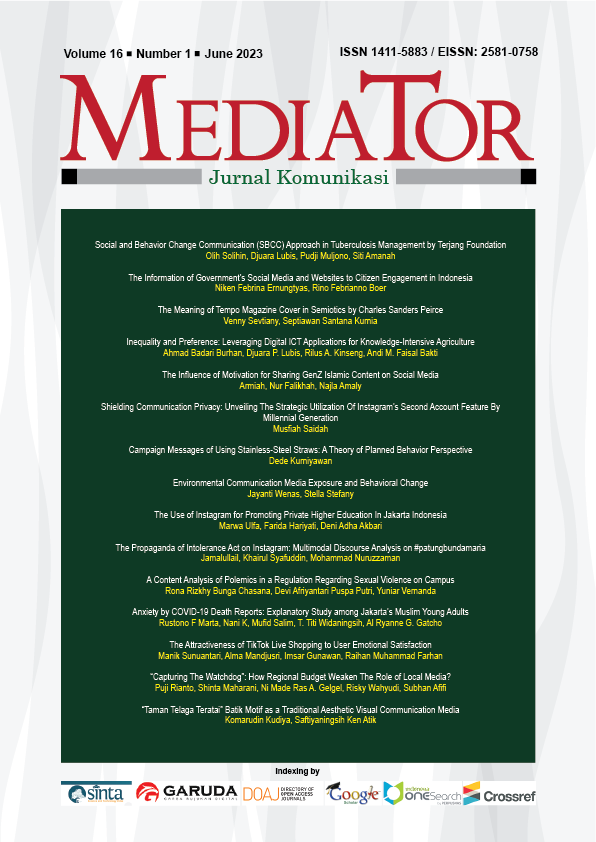Campaign Messages of Using Stainless-Steel Straws: A Theory of Planned Behavior Perspective
DOI:
https://doi.org/10.29313/mediator.v16i1.2175Keywords:
climate, stainless steel straws, social media, Structural Equational ModellingAbstract
Tackling climate change is the 13th goal in the Sustainable Development Goals (SDGs). One of the simple actions that can be taken to prevent the issue of climate change is the use of environmentally friendly straws, specifically the use of stainless-steel straws. For the public to know about the issue of climate change, social media has an important role. This study aims to see the effect of the exposure of messages on social media related to climate change issues on the behavior to use stainless-steel straws. In addition, this study uses predictors of the Theory of Planned Behavior, namely attitudes, subjective norms, and Perceived Behavioral Control (PBC). Using Structural Equation Modeling (SEM), the study results show that attitudes, subjective norms, and Perceived Behavioral Control (PBC) directly influence intentions and indirectly influence the behavior of using stainless-steel straws. Another finding is that exposure to persuasive messages on social media related to the use of environmentally friendly straws owned by family and close friends also has a direct positive effect on attitudes, subjective norms, Perceived Behavioral Control, and behavioral intentions, which in turn have a positive indirect effect on the behavior of using stainless-steel straws.
References
Aeni, S. N. (2022, June 12). Memaha¬mi Contoh Perubahan Iklim dan Upaya untuk Mengatasinya. Kata-data. https://katadata.co.id/agung/ berita/62a30103c430d/memaha¬mi-contoh-perubahan-iklim-dan-upa¬ya-untuk-mengatasinya
Ajzen, I. (1991). The theory of planned behavior. Academic Press, Inc.
Anderson, A. A. (2017). Effects of Social Media Use on Climate Change Opin¬ion, Knowledge, and Behavior. In Oxford Research Encyclopedia of Climate Science. Oxford University Press. https://doi.org/10.1093/acre¬fore/9780190228620.013.369
Asmuni, S., Yusoff, S., & Mohd Jafri, N. L. A. (2021). Predictors of intention to use reusable drinking straw. Jour¬nal of Emerging Economies and Is¬lamic Research, 9(2), 88. https://doi. org/10.24191/jeeir.v9i2.12739
Bappenas. (2015). Penanganan Perubahan Iklim. Bappenas. https://sdgs.bappe¬nas.go.id/tujuan-13/
Belinga, B., Chervier, C., & Lescuyer, G. (2021). Impact of a Media Campaign on Consumers’ Purchasing Intentions of Legal Timber in Cameroon. Society and Natural Resources, 34(5), 603– 620. https://doi.org/10.1080/08941920 .2020.1855686
Chan, K. (1998). Mass communication and pro environmental behaviour: Waste recycling in Hong Kong. Journal of Environmental Management, 52(4), 317–325. https://doi.org/10.1006/ jema.1998.0189
Chetioui, Y., Benlafqih, H., & Lebdaoui, H. (2020). How fashion influencers con¬tribute to consumers’ purchase inten¬tion. Journal of Fashion Marketing and Management, 24(3), 361–380. https://doi.org/10.1108/JFMM-08- 2019-0157
Dalrymple, K. E., Young, R., & Tully, M. (2016). “Facts, Not Fear.” Science Com¬munication, 38(4), 442–467. https:// doi.org/10.1177/1075547016655546
De Fano, D., Schena, R., & Russo, A. (2022). Empowering plastic recycling: Empir¬ical investigation on the influence of social media on consumer behavior. Resources, Conservation and Recy¬cling, 182. https://doi.org/10.1016/j. resconrec.2022.106269.
Dhir, A., Khalil, A., Kaur, P., & Rajala, R. (2019). Rationale for “Liking” on Social Networking Sites. Social Science Com¬puter Review, 37(4), 529–550. https:// doi.org/10.1177/0894439318779145
Edwin, Y. (2017, May 9). Jumlah sampah se¬dotan di Indonesia bisa 3 kali kelilingi Bumi. Lokadata. https://lokadata.id/ artikel/jumlah-sampah-sedotan-di-in¬donesia-bisa-3-kali-kelilingi-bumi
Ellora, D. (2019, February 11). Jaga Kele¬starian Laut, Kampanye Anti Sedotan Plastik Semakin Marak di Indonesia. Sudahkah Anda Berpartisipasi? So¬ciolla. https://journal.sociolla.com/ lifestyle/kampanye-anti-sedotan-plas¬tik-di-indonesia
Fishbein, M. , & A. I. (2011). Predicting and changing behavior: The reasoned ac¬tion approach. Taylor & Francis.
Gerakan Indonesia Bersih. (2020). Pengu¬rangan Penggunaan Plastik. Gerakan Indonesia Bersih.
Gil de Zúñiga, H. (2012). Social Media Use for News and Individuals’ Social Capital, Civic Engagement and Polit¬ical Participation. Journal of Comput¬er-Mediated Communication, 17(3), 319–336. https://doi.org/10.1111/ j.1083-6101.2012.01574.x
Huang, Y., Aguilar, F., Yang, J., Qin, Y., & 101
Wen , Y. (2021). Predicting citizens’ participatory behavior in urban green space governance: Application of the extended theory of planned behavior. Urban Forestry and Urban Green¬ing, 61. https://doi.org/10.1016/j. ufug.2021.127110
Inspirasiana. (2022, April 22). Ada 80 Juta Sampah Sedotan Plastik Tiap Hari di Indonesia, Ini 3 Cara Menguranginya! Kompasiana. https:// www.kompasianaispirasianakompasiana6909/6261bdf7ef62f¬644fa7772d8/ada-80-juta-sampah-sedotan-plastik-tiap-hari-di-in-donesia-ini-3-cara-mengurangin¬ya?page=1&page_images=1
Intan, G. (2018, November 19). Selamatkan Lingkungan, Gerakan Tanpa Sedotan Plastik Mulai Nge-Trend di Masyarakat. Voaindonesia. https://www. voaindonesia.com/a/selamatkan-lingkungan-gerakan-tanpa-sedotan-mulai-nge-trend-di-masyarakat/4664637.html
KLHK. (2019, February 21). Pemerintah Luncurkan Gerakan Indonesia Bersih. KLHK. https://dataalam.menlhk.go.id/ berita/2019/02/21/pemerintah-luncurkan-gerakan-indonesia-bersih#:~:text=Program%20 Gerakan%20 Indonesia%20Bersih%20 merupakan,merupakan%20 Hari%20Peduli%20Sampah%20 Nasional
Konstantoulaki, K., Rizomyliotis, I., Cao, Y., & Christodoulou, I. (2022). Social media engagement and the determinants of behavioural intentions of university online programme selection: the moderating role of mindfulness. Corporate Communications, 27(3), 457–469. https://doi.org/10.1108/CCIJ-07- 2021-0081
León, B., Bourk, M., Finkler, W., Boykoff, M., & Davis, L. S. (2021). Strategies for climate change communication through social media: Objectives, approach, and interaction. Media International Australia. https://doi. org/10.1177/1329878X211038004
Mohammed, A., & Ferraris, A. (2021). Factors influencing user participation in social media: Evidence from twitter usage during COVID-19 pandemic in Saudi Arabia. Technology in Society, 66. https://doi.org/10.1016/j. techsoc.2021.101651
Neuman, W. L. (William L. (2014). Social research methods : qualitative and quantitative approaches.
Nu’man, T. M., & Noviati, N. P. (2021). Perilaku sadar lingkungan dalam perspektif Theory of Planned Behavior: Analisis terhadap intensi penggunaan kantong dan sedotan plastik pada mahasiswa. Jurnal Ecopsy, 8(2), 165. https://doi. org/10.20527/ecopsy.2021.10.016
Nurul, L. (2022, June 29). Perubahan Iklim dan Bagaimana Pemberitaannya di Media Indonesia. Kumparan. https:// kumparan.com/luginanurul193/ perubahan-iklim-dan-bagaimana-pemberitaannya-di-media-indonesia-1yMKkbAcGah/full
Pourmand, G., Doshmangir, L., Ahmadi, A., Noori, M., Rezaeifar, A., Mashhadi, R., Aziminia, R., Pourmand, A., & Gordeev, V. S. (2020). An application of the theory of planned behavior to self-care in patients with hypertension. BMC Public Health, 20(1). https:// doi.org/10.1186/s12889-020- 09385-y
Priliantini, A., Krisyanti, K., & Situmeang, I. V. (2020). Pengaruh 102
Kampanye #PantangPlastik terhadap Sikap Ramah Lingkungan (Survei pada Pengikut Instagram @GreenpeaceID). Jurnal Komunika : Jurnal Komunikasi, Media Dan Informatika, 9(1), 40. https://doi.org/10.31504/komunika. v9i1.2387
Putri, A. S. (2022, May 30). Kaum Muda Memiliki Peran Penting dalam Isu Perubahan Iklim Lewat Kampanye Be Seen Be Heard: The Body Shop Indonesia. Fimela. https://www. fimela.com/lifestyle/read/4974710/ kaum-muda-memiliki-peran-penting-dalam-isu-perubahan-iklim-lewat-kampanye-be-seen-be-heard-the-body-shop-indonesia
Safitri, K. (2022, March 7). Indonesia Hasilkan 93 Juta Ton Sampah Sedotan Plastik Per Tahun, Ekonomi Sirkular Bisa Jadi Solusinya. Kompas. https://money.kompas.com/ read/2022/03/07/123024426/ indonesia-hasilkan-93-juta-ton-sampah-sedotan-plastik-per-tahun-ekonomi?page=all
Sartika, R. E. A. (2018, August 4). Studi Ungkap Plastik Turut Sebabkan Perubahan Iklim. Kompas. https://sains.kompas.com/ read/2018/08/04/110429123/studi-ungkap-plastik-turut-sebabkan-perubahan-iklim
Syafrikurniasari, N., & Widiani, P. (2020). Pengaruh Pesan Kampanye No Straw Movement Di Media Sosial Terhadap Perubahan Sikap Publik. 4(1), 17–26. http:// ojs.stiami.ac.id
Teoh, C. W., Koay, K. Y., & Chai, P. S. (2022). The role of social media in food waste prevention behaviour. British Food Journal, 124(5), 1680–1696. https://doi. org/10.1108/BFJ-04-2021-0368
Ullman, J. B., & Bentler, P. M. (2012). Structural Equation Modeling. In Handbook of Psychology, Second Edition. John Wiley & Sons, Inc. https://doi. org/10.1002/9781118133880. hop202023
Yang, Q., & Wu, S. (2021). How Social Media Exposure to Health Information Influences Chinese People’s Health Protective Behavior during Air Pollution: A Theory of Planned Behavior Perspective. Health Communication, 36(3), 324–333. https://doi.org/10.1080/10410236.2 019.1692486
Yang, Y., Ma, X., & Myrick, J. G. (2022). Social media exposure, interpersonal network, and tampon use intention: A multigroup comparison based on network structure. Journal of Health Psychology. https://doi. org/10.1177/13591053221120332
Downloads
Published
Issue
Section
License
Copyright (c) 2023 Author

This work is licensed under a Creative Commons Attribution-ShareAlike 4.0 International License.























